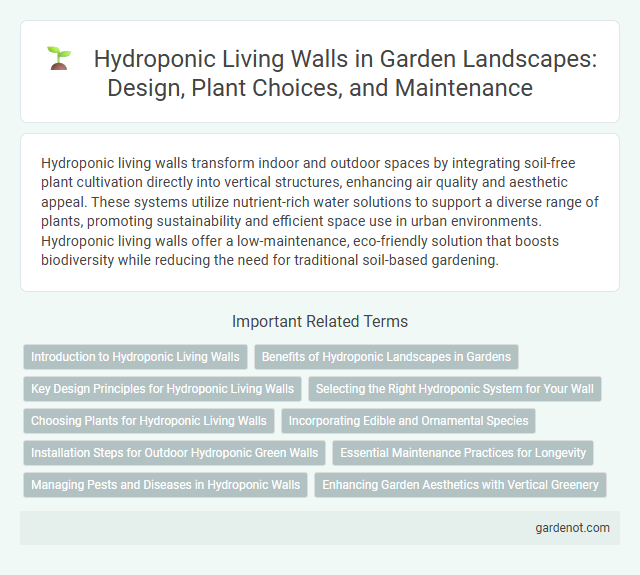Hydroponic living walls transform indoor and outdoor spaces by integrating soil-free plant cultivation directly into vertical structures, enhancing air quality and aesthetic appeal. These systems utilize nutrient-rich water solutions to support a diverse range of plants, promoting sustainability and efficient space use in urban environments. Hydroponic living walls offer a low-maintenance, eco-friendly solution that boosts biodiversity while reducing the need for traditional soil-based gardening.
Introduction to Hydroponic Living Walls
Hydroponic living walls use nutrient-rich water solutions instead of soil to cultivate plants vertically, optimizing space and enhancing air quality. These walls support diverse plant species, promoting sustainable urban greening and reducing the urban heat island effect. Incorporating hydroponic technology, living walls require less water and enable precise control over plant nutrition, leading to healthier growth and lower maintenance.
Benefits of Hydroponic Landscapes in Gardens
Hydroponic living walls offer significant benefits for gardens by maximizing space through vertical planting and reducing soil dependency, which minimizes pest issues and soil-borne diseases. These systems enhance water efficiency by recycling nutrient solutions, leading to lower consumption compared to traditional gardening methods. Additionally, hydroponic landscapes improve air quality, increase biodiversity, and provide year-round greenery with faster plant growth rates.
Key Design Principles for Hydroponic Living Walls
Key design principles for hydroponic living walls emphasize optimal water circulation systems to ensure consistent nutrient delivery and prevent root rot. Selecting lightweight, durable materials and modular panels facilitates efficient installation and maintenance in varied environments. Adequate lighting, ventilation, and plant species compatibility further enhance growth performance and system longevity.
Selecting the Right Hydroponic System for Your Wall
Choosing the appropriate hydroponic system for a living wall depends on factors such as plant species, wall size, and light exposure. Nutrient film technique (NFT) and drip systems are popular for their efficient water use and nutrient delivery in vertical gardens. Proper system selection ensures optimal root oxygenation and plant growth, resulting in a thriving, low-maintenance hydroponic living wall.
Choosing Plants for Hydroponic Living Walls
Selecting plants for hydroponic living walls involves prioritizing species with lightweight root systems and high adaptability to nutrient-rich water environments. Popular choices include pothos, philodendron, and ferns, which thrive in vertical setups due to their tolerance for varying light and moisture levels. Ensuring plant compatibility with hydroponic systems enhances growth efficiency, aesthetic appeal, and long-term sustainability of the living wall.
Incorporating Edible and Ornamental Species
Hydroponic living walls combine edible and ornamental species to create visually appealing and functional green spaces ideal for urban environments. Incorporating nutrient-rich herbs like basil, mint, and kale alongside flowering plants such as petunias and ferns enhances biodiversity while maximizing vertical growth potential. This symbiotic design optimizes space, improves air quality, and provides fresh, homegrown produce directly within the landscape.
Installation Steps for Outdoor Hydroponic Green Walls
Outdoor hydroponic living walls require a sturdy frame installation using weather-resistant materials such as galvanized steel or treated wood to withstand environmental conditions. Secure a waterproof backing to protect the building surface, followed by mounting the hydroponic growing pockets or panel system designed for optimal water flow and plant support. Connect the irrigation system, including pumps, tubing, and nutrient reservoirs, ensuring precise delivery of water and nutrients to maximize plant health and growth efficiency in outdoor settings.
Essential Maintenance Practices for Longevity
Hydroponic living walls require consistent nutrient solution monitoring to maintain optimal pH levels between 5.5 and 6.5, ensuring efficient nutrient uptake and plant health. Regular inspection and cleaning of the irrigation system prevent clogs and algae buildup, crucial for uninterrupted water flow and root oxygenation. Periodic pruning and removal of dead leaves enhance airflow, reduce pest risks, and support the longevity of the hydroponic living wall.
Managing Pests and Diseases in Hydroponic Walls
Effective management of pests and diseases in hydroponic living walls relies on maintaining optimal humidity and airflow to prevent fungal growth and insect infestations. Utilizing biological controls such as beneficial insects and applying organic, systemic pesticides can protect plants without compromising the hydroponic system's balance. Regular monitoring and prompt removal of affected plant material are critical to sustaining healthy growth in hydroponic wall installations.
Enhancing Garden Aesthetics with Vertical Greenery
Hydroponic living walls transform ordinary spaces by integrating soil-free vertical greenery, creating lush, vibrant installations that optimize limited outdoor or indoor areas. These walls employ nutrient-rich water solutions to support plant growth, promoting healthier foliage and reducing maintenance compared to traditional gardens. Vertical hydroponic systems enhance air quality, increase biodiversity, and serve as dynamic, space-efficient design elements that elevate garden aesthetics.
Hydroponic living wall Infographic

 gardenot.com
gardenot.com